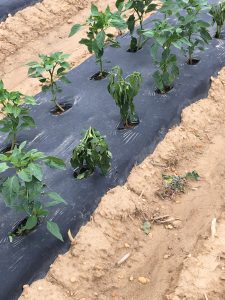Sweet Corn
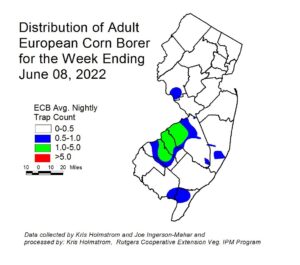 Low numbers of European corn borer (ECB) moths continue to be captured throughout the state. The highest adult activity is currently from Gloucester through Burlington counties (see map at right). Whorl corn is the primary target for egg laying, and injury well over the 12% threshold has been found in Hunterdon County this week. Feeding percentages in many areas have been relatively low, but this pest still poses a threat to plantings now approaching full tassel. It is typical for feeding percentages to rise as the moth catch declines. We expect feeding to increase for the next 1-2 weeks before peaking.
Low numbers of European corn borer (ECB) moths continue to be captured throughout the state. The highest adult activity is currently from Gloucester through Burlington counties (see map at right). Whorl corn is the primary target for egg laying, and injury well over the 12% threshold has been found in Hunterdon County this week. Feeding percentages in many areas have been relatively low, but this pest still poses a threat to plantings now approaching full tassel. It is typical for feeding percentages to rise as the moth catch declines. We expect feeding to increase for the next 1-2 weeks before peaking.
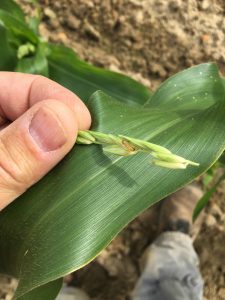 Look for the characteristic “shot-hole” type of feeding (photo below at right) and consider treating when infested plants exceed 12% in a 50 plant sample. As plantings proceed to the pre-tassel stage, ECB larvae may be found in emerging tassels (see photo at left). It is a good idea to treat individual plantings as they move into the full tassel/first silk stage one time. This eliminates any ECB larvae that have emerged with the tassels as they begin to move down the stalk to re-enter near developing ears.
Look for the characteristic “shot-hole” type of feeding (photo below at right) and consider treating when infested plants exceed 12% in a 50 plant sample. As plantings proceed to the pre-tassel stage, ECB larvae may be found in emerging tassels (see photo at left). It is a good idea to treat individual plantings as they move into the full tassel/first silk stage one time. This eliminates any ECB larvae that have emerged with the tassels as they begin to move down the stalk to re-enter near developing ears.
Useful insecticides for this particular application include synthetic 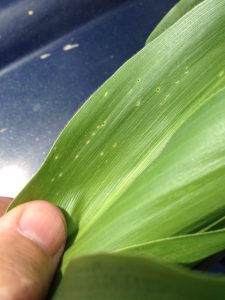 pyrethroids (IRAC Grp 3), spinosyns (including OMRI approved Entrust) IRAC Grp 5), and diamides such as Coragen or Vantacor (IRAC Grp 28) or materials such as Besiege which include the active ingredient in Coragen. Synthetic pyrethroids alone should NOT be used for corn earworm (CEW) protection on silking corn. Control with these materials is very inconsistent.
pyrethroids (IRAC Grp 3), spinosyns (including OMRI approved Entrust) IRAC Grp 5), and diamides such as Coragen or Vantacor (IRAC Grp 28) or materials such as Besiege which include the active ingredient in Coragen. Synthetic pyrethroids alone should NOT be used for corn earworm (CEW) protection on silking corn. Control with these materials is very inconsistent.
The highest nightly trap catches of ECB for the week ending 6/08/22 are as follows:
| Medford 3 | Centerton 1 | New Egypt 1 |
| Cinnaminson 2 | Clinton 1 | Port Murray 1 |
| Downer 2 | Eldora 1 | Sergeantsville 1 |
| Blairstown 1 | Milford 1 |
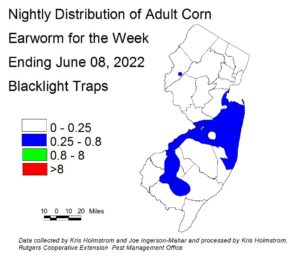 Corn earworm (CEW) moths captures from blacklight traps, while low, continue to occur in a number of locations (see blacklight map at left). We are nearly complete bringing pheromone traps online, and we will use a combination of these trap types to derive silk spray schedules by region. At present, pheromone trap captures are low except for sites in Gloucester and Salem counties, and these traps are indicating a more conservative schedule in parts of the state. The number of pheromone traps deployed is much lower, resulting in much broader color bands on the map. It is also important to understand that pheromone traps are more sensitive than blacklight traps, and thresholds are adjusted to account for the higher catches typical of this trap type. Silking corn is at risk of CEW infestation at this time. On the blacklight map, blue areas represent a 4-5 day schedule. On the pheromone map (below at right), green represents a 4-5 day schedule. Be sure to access information from this publication in the upcoming weeks to determine how frequently you should treat silking sweet corn to protect it from CEW infestation.
Corn earworm (CEW) moths captures from blacklight traps, while low, continue to occur in a number of locations (see blacklight map at left). We are nearly complete bringing pheromone traps online, and we will use a combination of these trap types to derive silk spray schedules by region. At present, pheromone trap captures are low except for sites in Gloucester and Salem counties, and these traps are indicating a more conservative schedule in parts of the state. The number of pheromone traps deployed is much lower, resulting in much broader color bands on the map. It is also important to understand that pheromone traps are more sensitive than blacklight traps, and thresholds are adjusted to account for the higher catches typical of this trap type. Silking corn is at risk of CEW infestation at this time. On the blacklight map, blue areas represent a 4-5 day schedule. On the pheromone map (below at right), green represents a 4-5 day schedule. Be sure to access information from this publication in the upcoming weeks to determine how frequently you should treat silking sweet corn to protect it from CEW infestation.
The highest nightly blacklight trap catches of CEW for the week ending 6/08/22 are as follows:
| Centerton 1 | East Vineland 1 |
| Cinnaminson 1 | Farmingdale 1 |
| Crosswicks 1 | Matawan 1 |
| Downer 1 | Port Murray 1 |
The highest nightly pheromone trap catches of CEW for the week ending 6/08/22 are as follows: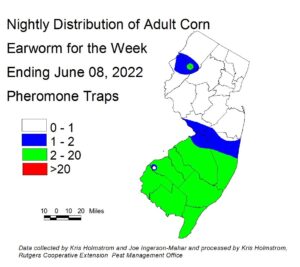
| Monroeville 23 | Allamuchy 2 | Dayton 1 |
| Woodstown 8 | Farmingdale 2 | Oldwick 1 |
| East Vineland 4 | Georgetown 2 | |
| Pedricktown 3 | Beckett 1 |
Silking Spray Schedules*:
South – 4 days
Central – 4-5 days
North – 6 days
*These recommendations are based on regional catches. Adhere to tighter spray schedules if indicated by local trap catches. Synthetic pyrethroids alone should NOT be used for corn earworm (CEW) protection on silking corn, or for fall armyworm (FAW) management at any stage. Control with these materials is very inconsistent.
Peppers
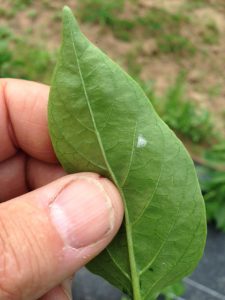 With ECB moth activity continuing, growers should be looking for ECB egg masses (see photo at left) on the underside of pepper leaves. The larvae that hatch from these eggs will bore into the central stem of pepper plants in the absence of suitable fruit. This damage causes the tops of the plant to die, and eliminating the crown set of fruit in the process. Check 2 leaves per plant on 5 consecutive plants in 10 random locations. Consider treating if 2 or more leaves are found to have ECB larvae on the lower surface.
With ECB moth activity continuing, growers should be looking for ECB egg masses (see photo at left) on the underside of pepper leaves. The larvae that hatch from these eggs will bore into the central stem of pepper plants in the absence of suitable fruit. This damage causes the tops of the plant to die, and eliminating the crown set of fruit in the process. Check 2 leaves per plant on 5 consecutive plants in 10 random locations. Consider treating if 2 or more leaves are found to have ECB larvae on the lower surface.
Phytophthora crown rot has begun to appear in some fields following warm temperatures and high soil moisture. Look for clusters of wilting plants (photo at right). Inspect the stem near the soil line. If a black lesion is present, it 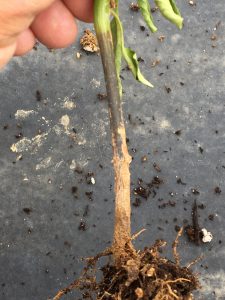 is likely that Phytophthora is responsible (photo at left). Please see Dr. Andy Wyenandt’s excellent post of last May (5/30/21) regarding Phytophthora management including proactive chemical applications.
is likely that Phytophthora is responsible (photo at left). Please see Dr. Andy Wyenandt’s excellent post of last May (5/30/21) regarding Phytophthora management including proactive chemical applications.
Pepper weevil –
No weevils have been trapped as yet. Weevil traps continue to be deployed across the region. A fact sheet is available for anyone interested in monitoring for pepper weevils on their own: FS1330: Monitoring and Management of Pepper Weevil in New Jersey (Rutgers NJAES). It is important to recognize that annual pepper weevil infestations come from currently infested fruit that are discarded near the growing crop. For this reason it is critical that growers not dump bad/rotten peppers that were purchased from terminal markets or other off-site sellers anywhere near their fields. These fruit may be infested with weevils. They should be discarded in closed containers.
Cucurbit Downy Mildew
A cucurbit downy mildew sentinel plot will be established at Snyder Farm in Hunterdon County later this week. This plot, consisting of pumpkin, watermelon, cantaloupe, butternut, acorn, cucumber and kabocha squash will be used to indicate the presence of cucurbit downy mildew in the region, and what crops are affected. For regional information on this important disease, see the Cucurbit Downy Mildew Forecast webpage: http://cdm.ipmpipe.org/.
Brown marmorated stink bug (BMSB)
Cooler evening temperatures have resulted in lower BMSB activity and extremely low trap catches. No map will appear in this addition.
